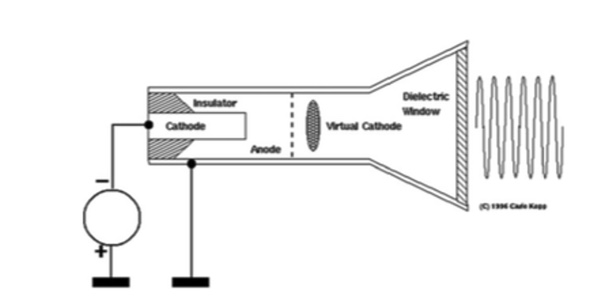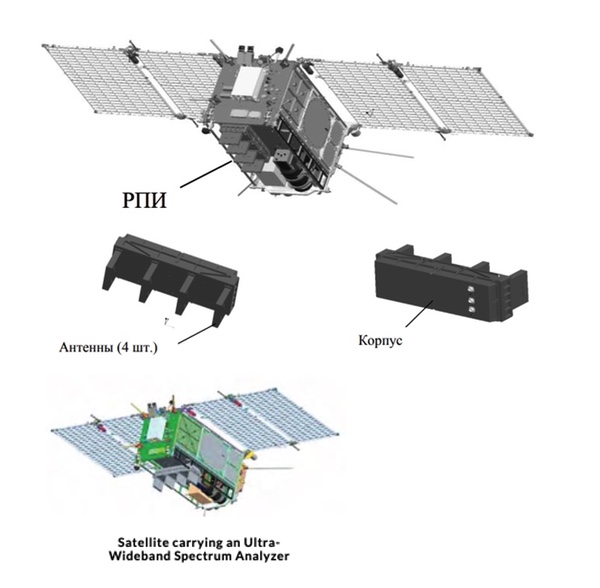Russian and Chinese development of radiofrequency directed energy weapons (RF DEW) for counterspaceby Markos Trichas and Matthew Mowthorpe
|
| The devastating potential of high-power microwave weapons has perhaps not received as much attention as other ASAT capabilities that, in our assessment, are further behind in development. |
The following table shows the space-based ASAT that are in currently in orbit. Nivelir, the co-orbital ASAT system considered the most mature and technically operational ASAT system, has received the most commentary from both US and UK Space Commands. To a lesser extent the Chinese SJ-21 grappler satellite, which performed ASAT-useful activities in GEO, has received a number of official press statements. However, the Numizmat satellite pales into insignificance when searching for official press statements condemning or highlighting Russia’s revolutionary achievement in space. The reason for this paucity of acknowledgement is unclear. This article analyses Russia’s recent launch, along the pursuit by China of similar capabilities for use in space.
Table 1: Russia and Chinese ASAT Capabilities in Space[2]
| Launch Date | Country | Satellite | System |
|---|---|---|---|
| 25/12/2013 | Russia | Cosmos 248, 2489, 2490, 2491 | Nivelir ASAT development |
| 5/2023 | Russia | Cosmos 2496, 24907, 2498, 2499 | Nivelir ASAT development |
| 23/6/2019 | Russia | Cosmos 2519, 2520, 2521, 2523 | Nivelir ASAT development |
| 10/7/2019 | Russia | Cosmos 2542, 2543 | Nivelir ASAT development |
| 5/2/2022 | Russia | Cosmos 2533, 1558 | Nivelir ASAT development |
| 16/5/2024 | Russia | Cosmos 2576 | Nivelir ASAT development |
| 5/2/2025 | Russia | Cosmos-2581, 2582, 2583 | Nivelir ASAT development |
| 1/8/2022 | Russia | Numizmat Cosmos 2558 | RF Directed Energy RF ASAT |
| 2013 | China | Tansuo 3, 4, 5 | Robotic Arm |
| 3/11/2016 | China | Shijian-17 | Optical and Sigint Proximity, Operations Testing possibly EW |
| 23/12/2018 | China | TJS-3 | Co-orbital ASAT Development |
| 24/10/2021 | China | SJ-21 | ASAT Development for Grappling and Proximity Operations |
Russia’s RF DEW counterspace development
Russia successfully launched on August 1, 2022, Kosmos 2558 (Numizmat), a probable RF directed energy weapon. Radiofrequency weapons are generally classified in two main groups: narrowband or high-power microwave (HPM) devices and ultra-wide band (UWB) or beamless devices, which are capable of being used in an ASAT role. Protective measures against nuclear EMPs, such as radiation hardening and ensuring sensitive electrical components are shielded behind such “hardening” of the satellite bus, are not as effective against HPM and UWB weapons because of the higher frequencies and shorter pulse times.[3] Russia has deployed both a UWB analyzer and a HPM payload as can be seen from figure 2.
The destructive capabilities of RF DEW in space were highlighted in JPL’s own satellite design handbook when it declared that any penetration of a satellite body, such as the satellite’s star tracker used for satellite orientation, can be an infiltration point for RF DEW to cause damage. The subsequent impact can often have further chain reaction activities on other electronic subsystems. This is highly difficult to predict and cannot be fully simulated either in a vacuum chamber on the ground or through computer simulations. It would be too late for a satellite operator, especially one which operates a critical defensive role such as an early warning satellite, to discover the destructive impact of RF DEW and suddenly be faced with a significantly decreased coverage of space-based early warning from strategic missiles.
China’s RF DEW counterspace development
In 2017, in a report for a hearing of the US-China Economic Security Review Commission, an eminent China security expert, Dean Cheng, testified that the People’s Liberation Army was pursuing the development of high power-output microwaves with a radiated energy hundreds or even 10,000 times greater that a radar.[5] This could even penetrate the generally isolated satellite systems, which are designed to shielded from the effects of radiation in space.
More recently, the annual Space Threat Assessment by the Center for Strategic and International Studies highlighted how several research papers had been documented by Chinese scientists on military technologies, including microwave technologies.[6] This once again did not discount the military utility of HPM as a counterspace weapon. What is somewhat surprising, given the depth of Chinese scientific publications across a bewildering amount of topics, is the absence of publicly available information on specific development and testing of these technologies. This could indicate that the historical interest highlighted in the US-China Economic and Security Review Commission, combined with the devastating potential of HPM in space against satellites, means that China has placed a cloak of secrecy around their possible advances into such systems.
In 2022, Chinese scientists developed a high-power relativistic klystron amplifier (RKA) capable of creating short pulses up to 5 megawatts in the Ka-band.[7] RKA are technologies capable of creating high-power microwave beams and have applications for radars, particle acceleration, and communication systems. The development of this type of power enables the potential deployment on satellites capable of disrupting or even damaging the electrical components at relatively close range. Another group of Chinese scientists researched using HPM to protect satellites from against such technologies. It is unlikely this is in anticipation of a threat from Russia’s Numizmat system, but more likely a potential threat from the US possible developing its own HPM ASAT counterspace capability.
| Russia and China are both developing RF DEW (referred to as high-power microwaves) for use in space as an extremely effective counterspace weapon. |
What is unknown is the level of potential cooperation between Russian scientists’ research and development in space with their satellite launch in 2022. The closer relationship between Russia and China in the aftermath of the invasion of Ukraine has opened up the potentially of cooperation on ASAT capabilities which was once considered to be strictly off-limits. In March 2023, another group of Chinese scientists reported developing capabilities generating power levels of 10 gigawatts to enable them to generate power sufficient to drive a high-power microwave beam weapon. This led to a successful use in February 2024 of a Stirling engine for a high-power microwave beam weapon capable of improving efficiency, which permits longer operation of an ASAT system.
High-power microwave sources
Flux compression generators (FCGs) are the basis for the generation of large electrical power pulses, whose output is constrained to below one megahertz. At this frequency many targets are difficult to attack with high power levels. The additional problem of focusing the energy will need to be overcome.
An HPM device can overcome these problems as its output is tightly focused, which provides a greater ability to couple sufficient energy on to the target.[8] A variety of HPM devices exist, one of which is the RKA mentioned above that the Chinese are focusing on. As a weapon, the vircator is better suited, as it provides a one-shot device providing a powerful single pulse of radiation, while at the same time being mechanically simple, small, and robust, and can operate over a broad band of frequencies. The power levels range from 170 kilowatts to 40 gigawatts over frequencies spanning the deci- and centimeter bands. A common configuration of the vircator is the axial vircator (AV), figure below.
 Axial virtual cathode oscillator[9] |
Assessment
Russia and China are both developing RF DEW (referred to as high-power microwaves) for use in space as an extremely effective counterspace weapon. Russia currently is developing such a capability in space, however it is difficult to ascertain the method and progress. China at present appears to be researching RKA with the ability to provide high levels of lethality for potential deployment in space, and at present, in open source, does not appear to have launched such a system in space. It is likely that China will deploy such a capability in the near term. An intelligence gap is the amount of cooperation between Russia and China in this area; if Russia is providing data to China, this may enable China to advance its capabilities quickly once it does launch such a system into space.
Endnotes
- The term Radio Frequency Directed Energy Weapon is the correct terminology for High Power Microwave. We have used the terms indiscriminately for ease of read throughout the article, as the references frequency refer to HPM.
- Derived from multiple sources, Bart Hendrickx, Project Nivelir: Russia’s inspection satellites (part1) The Space Review 28 April 2025, Jim Shell, The Integrity Flash, ISR University. Including authors assessment of course any errors are soley that of the authors.
- Bart Hendrickx, Russian research on space nukes and alternative counterspace weapons (part 2) The Space Review, 20 May 2024.
- Ibid.
- Dean Cheng, China’s Advance Weapons, Hearing before the US-China Economic and Security Review Commission, at the 115th Congress 1st Session, 23 February, 2017. I am grateful for Dean Cheng for indulging my obscure questions in correspondence. Dean Cheng was co-author of the Pentagon sponsored publication of Chinese Views of Warfare which is the most influential analysis of Chinese military views of the once called Revolution in Military Affairs at the turn of the century, which sewed the seeds of space being fundamental as domain for warfare.
- Clayton Swope, Kari A Bingen, Makena Young, and Kendra Lafave, Space Threat Assessment 2025, CSIS, Washington DC, US.
- Victoria Samson, Secure World Foundation, Annual Counterspace Report (Washington D.C,: United States, 2025)
- Bahman Zohuir, Directed Energy Beam Weapons, June 2019, Nature Switzerland, 277-278.
- Bahman Zohuir, Directed Energy Beam Weapons, June 2019, Nature Switzerland, 278.
Note: we are now moderating comments. There will be a delay in posting comments and no guarantee that all submitted comments will be posted.
